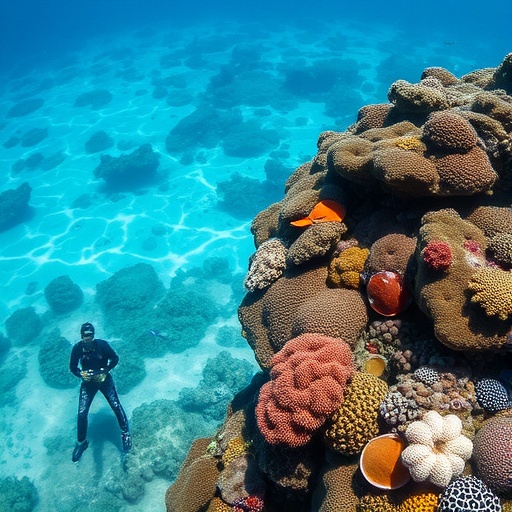The research conducted by Pisapia, Burn, and Hoey delves deeply into the intricate mechanisms of coral recovery versus reassembly after experiencing significant disturbances in the Central Maldivian Archipelago. With climate change and human activity posing unprecedented threats to coral ecosystems, this study aims to illuminate the pathways and processes that facilitate resilience and regeneration among these vital marine organisms. By carefully examining historical data, ecological interactions, and environmental conditions, the authors provide a comprehensive evaluation of the factors that influence coral health and sustainability in one of the most diverse and ecologically rich marine ecosystems in the world.
The Central Maldivian Archipelago is characterized by a vast expanse of coral reefs that support an array of marine life, making it a critical site for both biodiversity and ecological research. However, this vibrant ecosystem is under siege from various stressors, including rising sea temperatures, ocean acidification, and anthropogenic impacts. Understanding how corals respond to these adversities is crucial not only for their survival but also for the myriad species that rely on them. The researchers embark on a quest to differentiate between coral recovery—which pertains to the return of corals to their pre-disturbance condition—and coral reassembly—wherein the composition of coral species changes after disturbances.
The methodology employed in this research is multifaceted, involving extensive fieldwork, rigorous data collection, and innovative modeling techniques. The authors collected data from various sites across the archipelago, documenting species diversity, abundance, and the overall health of coral populations following major disturbances. By utilizing underwater surveys and remote sensing technology, they garnered a holistic view of the ecological landscape, which enabled them to track changes over time and across different environmental conditions. This robust approach not only bolstered the credibility of their findings but also provided a spatial context for their analysis.
One of the most significant findings from the study is the diverging recovery trajectories of different coral species. The research highlighted that certain species are more resilient than others, demonstrating the capacity to recover effectively following disturbances. This resilience is often attributed to specific physiological and reproductive traits, as well as adaptive mechanisms that allow these corals to withstand stressors better. Conversely, some species displayed a propensity toward reassembly, signifying a shift in community dynamics and composition rather than a straightforward recovery to original states. The implications of this finding are profound, suggesting that the ongoing health of coral ecosystems may not be a linear process and that diversity can potentially offer a buffer against future disturbances.
Another noteworthy aspect of the study is its exploration of the role of environmental variables in shaping recovery outcomes. The research team found that water temperature, nutrient levels, and light availability critically impacted coral health and recovery rates. Each of these factors serves as a crucial determinant in the resilience of coral species, presenting both opportunities and challenges for conservation efforts. For instance, areas with more favorable environmental conditions exhibited faster recovery times, while regions suffering from poor water quality and rising temperatures faced prolonged periods of distress. This nuanced understanding of the interconnection between environmental factors and coral health is essential for developing effective management strategies.
The authors also addressed the importance of local conservation initiatives and community involvement in coral restoration efforts. Engaging local communities not only fosters a sense of stewardship but also enhances the effectiveness of conservation strategies. By incorporating traditional ecological knowledge alongside scientific research, stakeholders can implement more culturally relevant and sustainable practices that benefit both coral ecosystems and local livelihoods. This collaborative approach to coral conservation underscores the need for multidisciplinary frameworks in addressing complex environmental challenges.
Moreover, the study invoked the concept of ecological thresholds and tipping points, presenting a compelling case for proactive measures in coral reef management. The authors underscored the significance of identifying and monitoring these thresholds to avert irreversible changes in coral communities. By establishing early warning systems that account for environmental shifts, researchers and policymakers can better predict coral responses to future disturbances and act swiftly to mitigate potential damage.
In a broader context, the findings of this research resonate with global efforts to combat the decline of coral reefs worldwide. While the Central Maldivian Archipelago serves as a case study, the insights gained from this work can be extrapolated to other regions facing similar challenges. The resilience exhibited by certain coral species serves as a beacon of hope, suggesting that targeted conservation strategies can bolster the recovery prospects for corals in different environments. By prioritizing research efforts that illuminate the complexities of coral ecosystems, the scientific community can guide policies that promote sustainability and biodiversity conservation.
As the world grapples with the stark realities of climate change, the urgency of protecting coral reefs cannot be overstated. These ecosystems serve as critical indicators of ocean health and are essential for the livelihoods of millions of people worldwide. The implications of coral recovery versus reassembly extend beyond ecological considerations; they touch upon social and economic dimensions that must be acknowledged in the global discourse on marine conservation.
In conclusion, the comprehensive analysis presented by Pisapia, Burn, and Hoey offers pivotal insights into the resilience of coral ecosystems to disturbances. Their exploration of recovery and reassembly dynamics is not only timely but essential for the future of coral conservation. The challenges faced by these ecosystems require an integrated approach that considers ecological, environmental, and social factors. Moving forward, it is imperative that stakeholders work collaboratively to implement science-driven solutions that will ensure the survival of coral reefs and the myriad life forms they support.
Subject of Research: Coral recovery and reassembly following disturbances
Article Title: Coral recovery versus reassembly following major disturbances in the Central Maldivian Archipelago
Article References: Pisapia, C., Burn, D., Hoey, A.S. et al. Coral recovery versus reassembly following major disturbances in the Central Maldivian Archipelago.
Coral Reefs (2025). https://doi.org/10.1007/s00338-025-02780-0
Image Credits: AI Generated
DOI: https://doi.org/10.1007/s00338-025-02780-0
Keywords: Coral recovery, coral reassembly, Central Maldivian Archipelago, disturbances, ecological resilience, environmental factors, conservation strategies, biodiversity.




